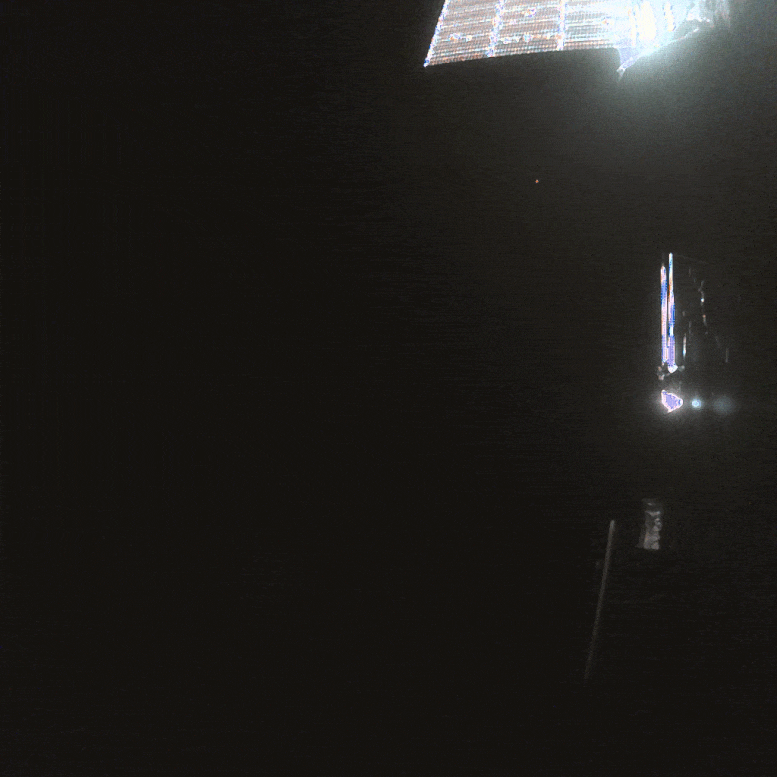ESA’s Jupiter Icy Moons Explorer (Juice) captured a stunning view of Earth shortly after its launch on April 14. The image was taken by the Juice monitoring camera 1 (JMC1) at 14:18 CEST, just four minutes after the spacecraft was launched at 14:14 CEST. JMC1 is located on the front of the spacecraft and looks diagonally up into a field of view that will eventually see deployed antennas and, depending on their orientation, part of one of the solar arrays. The image is a testament to the incredible technology and engineering behind the Juice mission and the ongoing efforts to explore our solar system and beyond. Credit: ESA/Juice/JCAM, CC BY-SA 3.0.

ESA’s Jupiter Icy Moons Explorer (Juice) has captured its first monitoring camera images after a successful launch on April 14. These cameras will record various deployments, including the Radar for Icy Moons Exploration antenna, while a scientific camera will capture high-resolution images of Jupiter and its icy moons in 2031.
The images were taken shortly after the spacecraft’s launch on an Ariane 5 rocket from Europe’s Spaceport in Kourou on April 14, with Earth serving as a stunning backdrop. These early images are a testament to the incredible technology and engineering behind the Juice mission and the ongoing efforts to explore our solar system and beyond. We look forward to the groundbreaking scientific discoveries that Juice will make in the years to come.

ESA’s Jupiter Icy Moons Explorer (Juice) captured a stunning view of Earth shortly after its launch on April 14. The image, taken by the Juice monitoring camera 1 (JMC1) at 14:38 CEST, shows the coastline around the Gulf of Aden to the right of center, with patchy clouds above land and sea. JMC1 is located on the front of the spacecraft and looks diagonally up into a field of view that will eventually see deployed antennas and, depending on their orientation, part of one of the solar arrays. Credit: ESA/Juice/JCAM, CC BY-SA 3.0 IGO.
Juice has two monitoring cameras located on the body of the spacecraft to record various deployments, providing 1024 x 1024 pixel snapshots. The images shown here are lightly processed with a preliminary color adjustment. A scientific camera will be used for taking high-resolution images of Jupiter and its icy moons once in the Jovian system in 2031. The ongoing Juice mission represents an incredible feat of engineering and scientific exploration, and we eagerly anticipate the groundbreaking discoveries that it will make in the years to come.

These images, captured by the Juice monitoring camera 1 (JMC1), show the rotation of the Jupiter Icy Moons Explorer’s solar arrays during their deployment after launch on April 14. JMC1 is located on the front of the spacecraft and looks diagonally up into a field of view that sees a part of one of the solar arrays and will eventually see deployed antennas.
The first image was taken at 15:28 CEST during solar array panel deployment, while the second image was taken at 15:32 CEST, just a few seconds before the deployment sequence was confirmed to have completed. Each of the two ‘wings’ comprises five 2.5 x 3.5 meter panels with a total area of 85 square meters. In total, they span 27 meters tip-to-tip and are crucial to provide the necessary power to run the spacecraft and operate the science instruments once exploring the Jupiter system, where sunlight is 25 times weaker than on Earth.
Their deployment, completed at 15:33 CEST, was critical to the success of the mission. Juice monitoring camera 2 (JMC2), located on the top of the spacecraft, is placed to monitor the multi-stage deployment of the 16-meter-long Radar for Icy Moons Exploration (RIME) antenna. RIME is an ice-penetrating radar that will be used to remotely probe the subsurface structure of the large moons of Jupiter. The ongoing Juice mission represents a major milestone in our efforts to explore the outer reaches of our solar system and unlock the secrets of the universe. Credit: ESA/Juice/JCAM, CC BY-SA 3.0 IGO.

Juice monitoring camera 2 (JMC2) captured this image shortly after the spacecraft’s launch on April 14. JMC2 is located on the top of the spacecraft and is positioned to monitor the multi-stage deployment of the 16-meter-long Radar for Icy Moons Exploration (RIME) antenna. In this image, RIME is seen in stowed configuration and will unfold in stages over the coming days. Images will be taken to capture the full deployment. Credit: ESA/Juice/JCAM, CC BY-SA 3.0 IGO.
The monitoring cameras will also be active during various mission operations, including gravity-assist flybys of the Moon, Earth, and Venus during the cruise to Jupiter. These cameras will provide valuable data and insights as we continue to explore the outer reaches of our solar system and unlock the secrets of the universe. The ongoing Juice mission represents an incredible achievement in engineering and scientific exploration, and we eagerly anticipate the groundbreaking discoveries that it will make in the years to come.
AƄout Juice
Juice is a bold mission that represents humanity’s daring venture into the outer reaches of our solar system. After an eight-year odyssey to Jupiter, the spacecraft will closely examine the gas giant and its trio of large, ocean-harboring moons: Ganymede, Callisto, and Europa. This enterprising mission will employ an array of remote sensing, geophysical, and in situ instruments to unravel the mysteries of these intriguing celestial bodies as potential abodes for past or present life.
Delving into Jupiter’s intricate magnetic, radiation, and plasma environment, Juice will investigate the planet’s interactions with its moons, using the Jupiter system as a model for gas giant systems throughout the cosmos. The mission will provide valuable insights into the formation and evolution of our solar system and the potential for life beyond Earth. The ongoing Juice mission represents an incredible achievement in scientific exploration and underscores the importance of continued efforts to explore and understand the universe around us.
Source: scitechdaily








